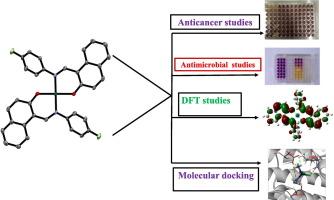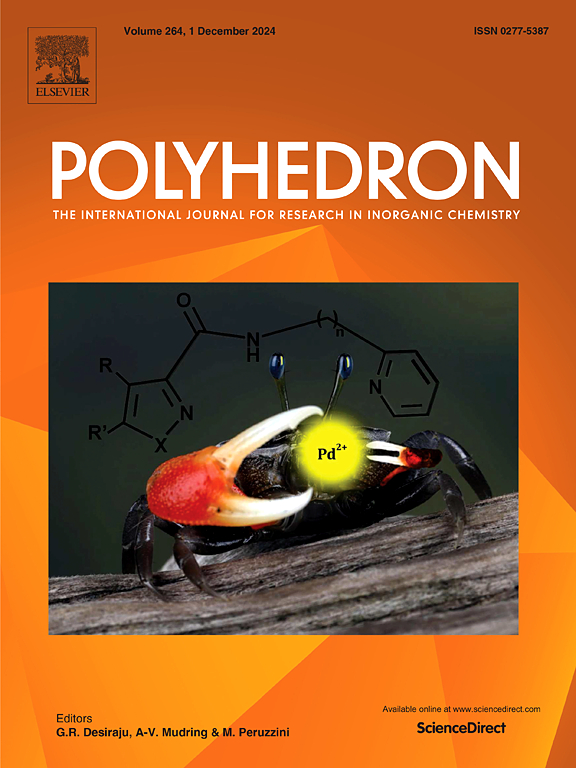Anticancer and antibacterial potential of Pd(II) complexes derived from N2O2-donor bidentate Schiff bases: Crystal structural analysis, DFT computational, in vitro and molecular docking investigations
IF 2.6
3区 化学
Q2 CHEMISTRY, INORGANIC & NUCLEAR
引用次数: 0
Abstract
A series of five palladium(II) complexes (1–5) of the formula [Pd-(L)2] (L = (E)-1-(((2,6-dimethylphenyl)imino)methyl)naphthalen-2-ol (L1) (1), (E)-1-(((2,6-diisopropylphenyl)imino)methyl)naphthalen-2-ol (L2) (2), (E)-1-(((2-fluorophenyl)imino)methyl)naphthalen-2-ol (L3) (3), (E)-1-(((4-fluorophenyl)imino)methyl)naphthalen-2-ol (L4) (4) and (E)-1-(((4-bromophenyl)imino)methyl)naphthalen-2-ol (L5) (5)) were synthesized and characterized by spectroscopic techniques and physicochemical methods. Single crystal X-ray crystallography confirmed the molecular structures of complexes 3 and 4 as neutral species in which one palladium(II) centre was coordinated to two bidentate Schiff bases (L3 and L4) via the imine nitrogen and naphtholate oxygen, adopting distorted square planar geometries. Density Functional Theory (DFT) was explored to study the electronic and molecular stability of the complexes. The B3LYP/3-21G DFT method gave the lowest optimization energies for all the complexes. Quantum chemical calculations revealed the energy bandgap of 1–5 ∆E = ∼3.0 eV. All the complexes showed moderate to good antimicrobial activities. Complexes 2 and 5 with MIC values of 125 μg/mL, were found to be more active than fluconazole (MIC value of 1000 μg/mL) against Candida albicans. Against methicillin-resistant Staphylococcus aureus (MRSA), complex 5 showed similar activity to gentamicin. Complex 1 was found to be more cytotoxic than cisplatin against both human cervical HeLa and human breast MDA-MB-231 cancer cell lines with cytotoxicity IC50 values of 22.3 ± 10.8 μM and 6.4 ± 0.1 μM respectively. However, the other complexes were inactive against these cell lines. Molecular docking simulation was carried out for complex 1 against cyclin-dependent kinase protein (3QTR) and serine-protein kinase (4DRH) important in cervical and breast cancer respectively and found to have improved docking scores and interactions compared to cisplatin. Complexes 2 and 5 were modelled against bactericidal targets nucleoid occlusion protein (5HSZ), chaperone (4E81), nucleoside phosphatase (7D8I) and peptidyl-propyl isomerase (5HW8) and were found to compare well against the standard drugs gentamicin and fluconazole. The findings show that complex 1 has good anticancer drug potential, while complexes 2 and 5, are promising antibiotic leads for further pre-clinical development.

由n2o2供体双齿希夫碱衍生的Pd(II)配合物的抗癌和抗菌潜力:晶体结构分析、DFT计算、体外和分子对接研究
一系列五钯(II)配合物(1 - 5)的公式(Pd - (L) 2) (L = 1 (E) - (((2, 6-dimethylphenyl)亚氨基的)甲基)naphthalen-2-ol (L1) (1), (E) 1 - (((2, 6-diisopropylphenyl)亚氨基的)甲基)naphthalen-2-ol (L2) (2), (E) 1 - (((2-fluorophenyl)亚氨基的)甲基)naphthalen-2-ol (L3) (3), (E) 1 - (((4-fluorophenyl)亚氨基的)甲基)naphthalen-2-ol (L4)(4)和(E) 1 - (((4-bromophenyl)亚氨基的)甲基)naphthalen-2-ol (L5)(5))是合成和光谱技术和物理化学方法。单晶x射线晶体学证实了配合物3和4的分子结构为中性物质,其中一个钯(II)中心通过亚胺氮和萘酚氧与两个双齿席夫碱(L3和L4)配位,采用扭曲的方形平面几何。利用密度泛函理论(DFT)研究了配合物的电子稳定性和分子稳定性。B3LYP/3-21G DFT方法的优化能最低。量子化学计算显示,1 ~ 5∆E = ~ 3.0 eV的能带隙。所有配合物均表现出中等至良好的抗菌活性。配合物2和5的MIC值为125 μg/mL,对白色念珠菌的抑制作用优于氟康唑(MIC值为1000 μg/mL)。对耐甲氧西林金黄色葡萄球菌(MRSA),复合物5表现出与庆大霉素相似的活性。复合物1对人宫颈癌HeLa和人乳腺MDA-MB-231癌细胞的细胞毒性均高于顺铂,IC50值分别为22.3±10.8 μM和6.4±0.1 μM。然而,其他复合物对这些细胞系无活性。我们对复合物1分别针对宫颈癌和乳腺癌中重要的周期蛋白依赖激酶蛋白(cyclin-dependent kinase protein, 3QTR)和丝氨酸蛋白激酶(serine-protein kinase, 4DRH)进行了分子对接模拟,发现复合物1与顺铂相比具有更高的对接评分和相互作用。配合物2和5对杀菌靶标类核阻断蛋白(5HSZ)、伴侣蛋白(4E81)、核苷磷酸酶(7D8I)和肽基丙基异构酶(5HW8)进行了建模,发现与标准药物庆大霉素和氟康唑相比,配合物2和5的效果良好。研究结果表明,配合物1具有良好的抗癌潜力,而配合物2和5是有希望进一步临床前开发的抗生素先导物。
本文章由计算机程序翻译,如有差异,请以英文原文为准。
求助全文
约1分钟内获得全文
求助全文
来源期刊

Polyhedron
化学-晶体学
CiteScore
4.90
自引率
7.70%
发文量
515
审稿时长
2 months
期刊介绍:
Polyhedron publishes original, fundamental, experimental and theoretical work of the highest quality in all the major areas of inorganic chemistry. This includes synthetic chemistry, coordination chemistry, organometallic chemistry, bioinorganic chemistry, and solid-state and materials chemistry.
Papers should be significant pieces of work, and all new compounds must be appropriately characterized. The inclusion of single-crystal X-ray structural data is strongly encouraged, but papers reporting only the X-ray structure determination of a single compound will usually not be considered. Papers on solid-state or materials chemistry will be expected to have a significant molecular chemistry component (such as the synthesis and characterization of the molecular precursors and/or a systematic study of the use of different precursors or reaction conditions) or demonstrate a cutting-edge application (for example inorganic materials for energy applications). Papers dealing only with stability constants are not considered.
 求助内容:
求助内容: 应助结果提醒方式:
应助结果提醒方式:


